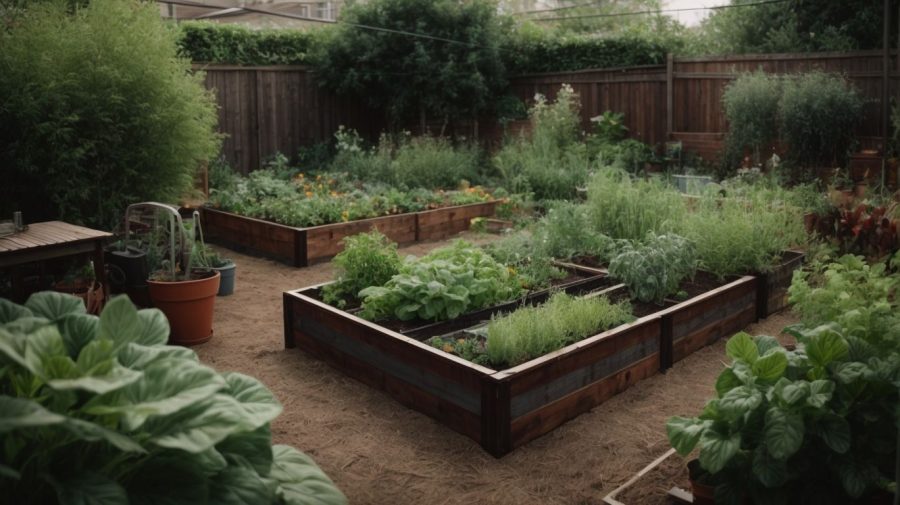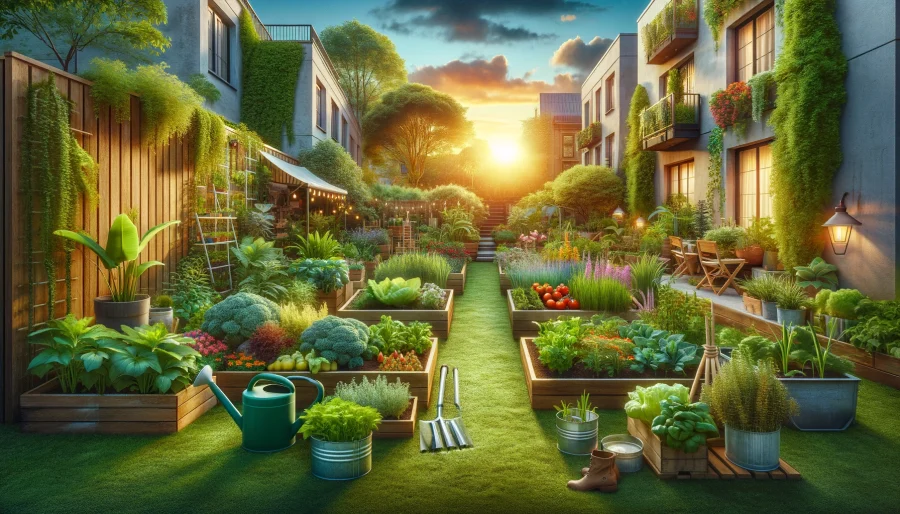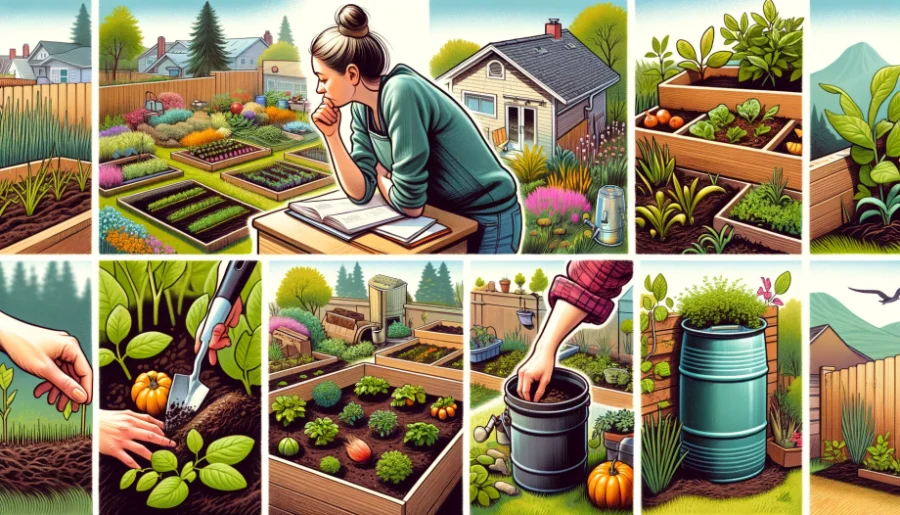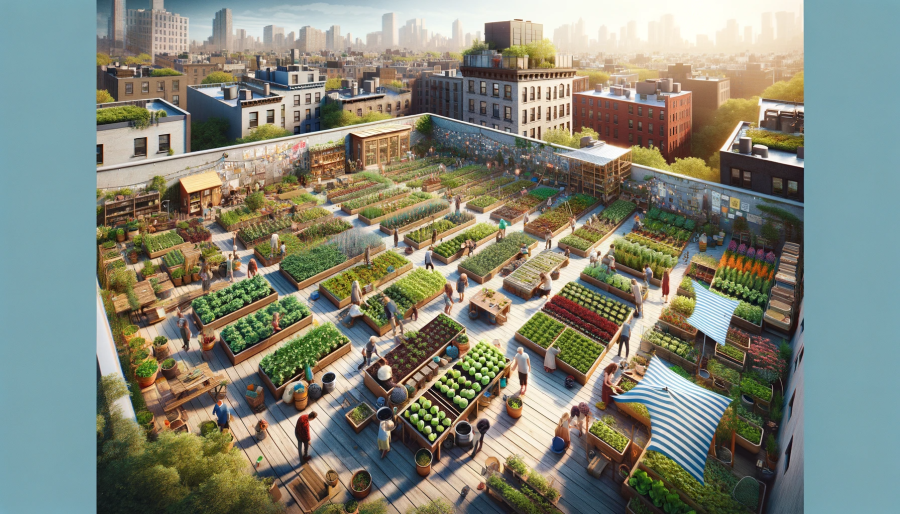We use affiliate links. If you purchase something using one of these links, we may receive compensation or commission.

Dive into the green thumbs world by getting started with urban backyard gardening! Discover the joys and how-tos to create your own urban oasis.
Starting an Urban Backyard Garden
Key Takeaways:
- Starting an Urban Backyard Garden involves:
- Assessing your space,
- Choosing suitable plants,
- And preparing your soil.
- With creativity and sustainable practices, even the smallest spaces can yield fresh produce and beautiful blooms, turning your urban area into a thriving green oasis.
Are you looking to bring the beauty and bounty of nature right to your doorstep?
Urban backyard gardening might be the perfect solution for you!
In this article, we will explore the benefits of starting your own garden, from access to fresh, organic produce to promoting physical activity and mental well-being.
We will also provide practical tips on how to get started, common challenges you may face, and strategies for successful gardening in limited urban spaces.
So grab your gardening gloves and get ready to dig in!
What Is Urban Backyard Gardening?
Urban backyard gardening refers to the practice of cultivating plants, vegetables, fruits, or herbs in a city environment, utilizing spaces such as rooftops, balconies, or community gardens to create green spaces within the urban landscape.
You can learn more about 15 types of urban gardens.
One of the key benefits of urban backyard gardening is its ability to promote sustainability within urban areas.
By growing food locally, residents can reduce their carbon footprint associated with transportation and packaging.
It allows individuals to have a direct hand in the production of their food, fostering a deeper appreciation for the natural world.
Urban backyard gardening also serves as a way to combat food deserts in cities, providing fresh produce to communities that may not have easy access to grocery stores.
Why Should You Start an Urban Backyard Garden?

Starting an urban backyard garden offers numerous advantages, including access to fresh, organic produce, cost-saving opportunities on grocery bills, environmental sustainability by reducing food miles, and fostering community engagement among city dwellers.
Urban gardening promotes physical activity and relaxation, as tending to plants can serve as a calming and fulfilling hobby.
It also enhances air quality by reducing the urban heat island effect, providing green spaces that absorb carbon dioxide and release oxygen into the atmosphere, creating a healthier environment for all residents.
In addition, urban gardening encourages biodiversity by attracting beneficial insects and pollinators, contributing to a balanced urban ecosystem.
Access to Fresh, Organic Produce
Embracing urban backyard gardening provides urban apartment dwellers with a convenient way to access fresh and organic fruits, vegetables, and herbs without depending solely on store-bought produce.
Having the opportunity to grow your own produce not only ensures that the fruits and vegetables are harvested at their peak ripeness, preserving their maximum nutritional value, but it also allows individuals to have a deeper connection to their food source.
Engaging in urban gardening promotes a healthier lifestyle by incorporating more nutrient-dense ingredients into daily meals, leading to improved overall well-being and increased energy levels.
Apartment dwellers can take advantage of utilizing small spaces creatively, such as balconies, rooftop gardens, or vertical plant walls, to cultivate a variety of crops.
Urban gardening enables individuals to take control of their food sources, reduce waste, and contribute to a more sustainable environment.
Saves Money on Grocery Bills
Engaging in urban backyard gardening can significantly reduce grocery bills by providing city dwellers with the opportunity to grow their own food, saving money on fresh produce purchases.
Urban gardening not only assists in cost-saving but also nurtures a sense of self-sustainability among individuals.
By cultivating fruits and vegetables in limited spaces such as balconies, rooftops, or community gardens, residents can source organic and fresh produce right at their doorstep.
This not only ensures a healthier diet but also minimizes the reliance on store-bought items, thereby cutting down household expenses significantly.
Urban gardening fosters a culture of sharing within the community, encouraging the exchange of seeds, plants, and gardening knowledge, further enriching the collective urban farming experience.
Reduces Environmental Impact
Urban backyard gardening plays a vital role in reducing the environmental impact of city living.
It promotes green spaces, reducing the carbon footprint associated with food transportation, and mitigating soil contamination through sustainable gardening practices.
Plus these benefits, urban gardening also contributes significantly to environmental sustainability by functioning as key habitat for various pollinators and wildlife, fostering biodiversity in urban areas.
By creating mini-ecosystems within cities, urban gardens support a healthier balance between human activities and natural processes.
These green spaces also act as natural air purifiers helping to offset the pollution generated by urban traffic and industries.
The presence of vegetation in cities helps regulate temperatures, reducing the urban heat island effect and enhancing overall environmental quality.
Urban areas usually experience the urban heat island (UHI) effect, that is, they are significantly warmer than surrounding rural areas. The temperature difference is usually larger at night than during the day,[1] and is most apparent when winds are weak, under block conditions, noticeably during the summer and winter. Wikipedia
Promotes Physical Activity and Mental Well-being
Engaging in urban backyard gardening not only promotes physical activity through planting and tending to plants but also enhances mental well-being by providing a therapeutic outlet, reducing stress, and fostering a connection with nature amidst city life.
One key benefit of urban gardening is the opportunity it offers for individuals to immerse themselves in outdoor activities, which can significantly contribute to their physical health.
The act of planting, watering, and caring for plants requires physical movement and can serve as a form of exercise, aiding in improving overall fitness levels.
Being outdoors exposes gardeners to fresh air and natural sunlight, essential elements for maintaining a healthy body.
Besides the physical benefits, urban gardening also plays a crucial role in enhancing mental wellness.
The process of tending to a garden can be meditative, allowing individuals to practice mindfulness and reduce stress levels.
Engaging with nature in an urban environment provides a sense of tranquility and offers a break from the hustle and bustle of city life.
This connection with nature has been shown to have positive effects on mental health, promoting relaxation and a sense of well-being.
How to Start an Urban Backyard Garden?

To begin an urban backyard garden, city dwellers need to assess available space, select suitable plants for containers or raised beds, prepare the soil, and ensure proper light exposure and drainage for successful growth.
When evaluating your available space, consider factors such as sunlight duration, shade patterns, and access to water sources.
Opt for plants that thrive in containers, such as herbs, salad greens, tomatoes, and peppers, to maximize limited space.
Soil preparation is crucial:
Enhance soil quality using compost, organic matter, and fertilizer.
Ensure good drainage by using containers with drainage holes or employing raised beds.
For indoor gardening, choose plants that adapt well to indoor conditions, like snake plants, ferns, or peace lilies.
Monitor temperature, and humidity levels, and provide adequate light through grow lights if needed.
Assess Your Space and Resources
Before starting your urban backyard garden, evaluate the available space on your balcony, patio, or backyard to determine the ideal locations for planting shrubs, vegetables, or ornamental plants based on sunlight exposure and accessibility.
One key aspect to consider when assessing your urban gardening space is the spatial constraints that might impact your planting choices.
Take note of any limited areas or obstacles that could restrict plant growth or accessibility.
Resource Availability is Another Critical Factor
Are you equipped with sufficient soil, water sources, and gardening tools needed for your chosen plants?
It’s also important to match plant suitability with the amount of sunlight each area receives.
Some plants thrive in full sunlight, while others prefer shaded spots.
Understanding these factors will help you create a flourishing urban garden.
Choose the Right Plants for Your Garden
Selecting the appropriate plants for your urban backyard garden involves considering factors such as sunlight exposure, plant compatibility, seed quality, and pest resistance to ensure successful growth and harvest of vegetables, herbs, or flowers.
When deciding on plant varieties for your urban garden, it’s crucial to assess the amount of sunlight your space receives throughout the day.
Some plants thrive in full sun, while others require partial shade to flourish.
Understanding these sun exposure needs will guide you in selecting plants that can thrive in your specific garden environment.
In terms of choosing seeds, opt for high-quality, non-GMO options that are well-suited for your local climate.
Consider the pest management strategies you’ll employ from the outset to prevent common problems such as aphids, caterpillars, or fungal issues.
Prepare Your Soil and Planting Beds
Preparing the soil and planting beds in your urban backyard garden involves assessing soil quality, amending soil with organic matter, constructing raised beds for improved drainage, and ensuring soil health by testing for contaminants.
Before starting any new gardening project, it’s crucial to understand the composition of your soil.
Conducting a soil test can provide valuable insights into its pH levels, nutrient content, and potential contaminants.
This information will help you determine the necessary amendments for optimal plant growth.
Once you have the test results, it’s time to start preparing your beds.
Constructing raised beds not only provides better drainage but also helps in soil aeration and minimizes compaction.
Consider incorporating compost, manure, or other organic materials to improve soil structure and fertility.
Plan and Maintain Your Garden
Efficient planning and consistent maintenance are essential for the success of your urban backyard garden, requiring attention to watering schedules, temperature fluctuations, pest control, and the maintenance of window boxes or containers.
One crucial aspect of garden planning in urban settings is considering the varying watering needs of different plants.
Researching and understanding the water requirements of your specific plant species can help you create an efficient watering schedule to prevent both over and under-watering.
In terms of temperature considerations, be mindful of microclimates in urban areas which may impact the growing conditions of your plants.
Shield sensitive plants from extreme temperatures by utilizing shade cloth or mulch during hot spells.
Pest Management Strategies
Pest management plays a key role in maintaining a healthy garden.
Implementing integrated pest management techniques such as introducing beneficial insects or using natural repellents can help control pests without harming the environment.
Regular upkeep of container plants is vital for their longevity. Check for root-bound plants, prune dead foliage, and refresh the soil periodically to ensure optimal growth.
Harvest and Enjoy Your Produce
The culmination of your urban backyard gardening efforts is the harvest of fresh and nutritious produce, including vegetables, herbs, fruits, or even yields from patio gardens or fruit trees, rewarding you for your dedication and green thumb.
Delving into the world of urban gardening not only offers the satisfaction of homegrown delicacies but also opens up a plethora of harvesting opportunities within limited spaces.
Experimenting with various plant types enables garden enthusiasts to enjoy a diverse range of flavors and textures on their plates.
Whether it’s the vibrant colors of freshly picked tomatoes, the fragrance of basil leaves just plucked from the plant, or the sweetness of strawberries from a hanging basket, each harvest showcases the true essence of nature’s bountiful offerings.
What Are the Common Challenges of Urban Backyard Gardening?
Urban backyard gardening presents various challenges, such as limited space for plant growth, pest and disease control issues, unpredictable climate conditions, and potential soil contamination risks in city environments.
One of the primary difficulties faced by urban gardeners is the restricted area available for cultivating plants, which often leads to the necessity of using vertical gardening techniques or compact plant varieties.
Pest management becomes a critical concern in tightly packed urban settings, where pests can easily spread and infest multiple plants, requiring diligent monitoring and organic pest control strategies.
The unpredictable nature of city climates poses challenges, necessitating the use of season-extending tools like row covers and cold frames to protect plants from sudden temperature fluctuations.
Limited Space
The primary challenge of urban backyard gardening is the limited space available for cultivating plants, necessitating creative solutions such as container gardening, vertical gardens, or community allotments to maximize greenery in compact urban settings.
Container gardening is a popular method for urban dwellers, allowing plants to thrive in small spaces. Utilizing various-sized containers and vertical stacking, gardeners can grow herbs, vegetables, and even small fruit trees on balconies or patios.
Vertical gardens provide an innovative approach by utilizing walls or structures to grow plants vertically, maximizing space efficiency.
Techniques like using hydroponic systems or pocket planters enable vertical gardens to thrive, adding a lush green touch to cityscapes.
Community gardening initiatives bring together residents to collectively cultivate urban spaces, transforming unused lots into vibrant green oases.
Sharing resources and knowledge fosters a sense of community while enhancing the environmental benefits of urban gardening.
Pest and Disease Control
Managing pests and diseases poses a significant challenge in urban backyard gardening.
It requires vigilant monitoring, timely intervention, climate-adapted plant choices, and dedicated time and effort to maintain a healthy garden ecosystem.
One of the key aspects of effective pest and disease control in urban gardening lies in preventive measures.
By implementing strategies such as crop rotation, intercropping, and proper sanitation practices, gardeners can proactively reduce the likelihood of pest infestations.
Selecting resilient plant varieties that are well-suited to the local climate can boost the garden’s natural defenses against common pests and diseases, thus minimizing the need for chemical interventions.
Considering the specific climatic conditions of the region is crucial as it directly impacts the prevalence of certain pests, guiding gardeners to tailor their pest management approaches accordingly.
Climate and Weather Conditions
Navigating the unpredictable climate and weather conditions in urban gardening requires careful planning, consideration of sun exposure levels, temperature fluctuations, and the resilience of plant species to thrive in changing environmental circumstances.
Managing sun exposure in urban gardening involves the strategic placement of plants, structures, and shade-providing elements to protect delicate foliage from scorching sun rays.
Implementing techniques like creating shade with trellises or utilizing reflective materials can help regulate the amount of sunlight reaching plants, ensuring they receive adequate but not excessive light.
In terms of temperature-sensitive plant care, monitoring weather forecasts becomes crucial to anticipate sudden temperature drops or spikes.
Utilizing tools such as frost cloth, cold frames, or even portable heaters during colder months can safeguard vulnerable plants from frost damage.
Selecting weather-resistant plant species with adaptive qualities, such as drought tolerance or frost hardiness, can significantly enhance urban gardening success.
Incorporating native plants or cultivars known for resilience in changing weather patterns can reduce maintenance efforts and promote long-term plant health in urban environments.
Time and Effort
Investing time and effort into urban backyard gardening is essential for planting, maintaining, and harvesting crops, requiring dedication, consistency, and accessible gardening practices to overcome the challenges of urban living.
Successful urban gardening involves a deep-rooted commitment to nurturing plants, ensuring they thrive amidst the concrete jungle.
Those who embark on this journey understand that each small step of planting a seed or tending to a vegetable patch contributes to a larger, sustainable ecosystem.
By investing time and effort into urban gardening, individuals not only cultivate food but also foster a sense of community and sustainability.
What Are Some Tips for Successful Urban Backyard Gardening?
To excel in urban backyard gardening, consider implementing vertical gardening techniques, companion planting strategies, sustainable gardening practices, and community engagement through participation in local garden groups.
Vertical gardening offers numerous benefits for urban gardeners, maximizing space efficiency and allowing for more plants in limited areas.
Utilize structures like trellises, vertical planters, and hanging baskets to grow crops vertically and create a stunning green wall.
Companion Planting
Companion planting is another valuable technique that involves planting compatible species together to improve growth, deter pests, and enhance flavor.
For example, pairing tomatoes with basil or planting marigolds near vegetables can naturally repel harmful insects.
Sustainable gardening practices, such as composting, mulching, and water conservation, contribute to environmental stewardship and long-term garden health.
Get involved in community garden projects to learn from experienced growers, exchange seeds and knowledge, and foster a sense of belonging within your neighborhood.
Use Vertical Gardening Techniques
Incorporating vertical gardening techniques in your urban backyard garden optimizes space utilization, increases plant diversity, enhances light exposure for growth, and allows for creative installations like window boxes to amplify greenery in limited city spaces.
Vertical gardening not only provides a solution for those with limited outdoor space in cities but also opens up a world of possibilities for plant enthusiasts.
By going vertical, plant lovers can expand their collection to include a variety of plants that thrive in different environments.
Optimizing light exposure in vertical gardens can lead to healthier and more vibrant plants.
With strategic placement, each plant can receive the necessary sunlight to fuel its growth, creating a lush and beautiful display.
Window boxes are versatile additions to urban gardens, offering a practical way to grow herbs, flowers, or even small vegetables.
They not only add charm to your space but also serve as functional green pockets to enhance the overall aesthetics.
Incorporate Companion Planting
Utilizing companion planting methods in your urban backyard garden fosters plant diversity, enhances natural pest control, encourages pollination through flowers, and supports symbiotic relationships between different plant species for overall garden health.
One of the key advantages of companion planting is its remarkable pest management benefits.
By strategically pairing specific plants together, you can naturally deter pests without the need for harmful chemicals, creating a balanced ecosystem within your garden.
Companion planting enhances floral attractions for pollinators such as bees and butterflies, ultimately increasing the yield of your crops through improved pollination.
This planting technique also embodies the concept of plant symbiosis, where certain plants work together to benefit one another by exchanging nutrients, repelling pests, or providing structural support.
The ecological advantages of diverse plant groupings in companion planting create a harmonious environment that promotes sustainable gardening practices and enhances crop productivity.
Implement Sustainable Gardening Practices
Adopting sustainable gardening practices in urban settings involves soil conservation, seed saving, water-efficient techniques, and ensuring compliance with city ordinances and permitting regulations to create an eco-friendly and responsible gardening environment.
By prioritizing soil health preservation, urban gardeners can enhance the quality and fertility of their growing medium, supporting robust plant growth and ecosystem health.
Seed preservation efforts play a crucial role in maintaining biodiversity, preserving heritage varieties, and ensuring resilient plant genetics for future generations.
Integrating water conservation strategies like drip irrigation, rainwater harvesting, and mulching helps reduce water waste and promote efficient resource utilization in urban gardening.
Join a Community Gardening Group

Engaging with a community gardening group in the city fosters collaboration, knowledge sharing, pest control solutions, and a sense of belonging among urban gardeners, creating a supportive network for learning and growing together.
By participating in such groups, individuals not only gain valuable insights into plant care and cultivation techniques but also benefit from a collective wisdom that spans generations.
Shared knowledge allows novices to learn from seasoned gardeners, while seasoned enthusiasts gain fresh perspectives from newcomers.
In terms of pest management strategies, the collective effort of a group can significantly reduce the impact of harmful insects and diseases on the community garden.
Collaboratively implementing organic solutions and preventative measures helps maintain a healthy and sustainable growing environment.
Frequently Asked Questions
Q. What is urban backyard gardening?
A. Urban backyard gardening is the practice of growing plants, fruits, and vegetables in a small space in an urban setting, such as a backyard or balcony.
Q. Why should I start urban backyard gardening?
A. There are many benefits to urban backyard gardening, including access to fresh and organic produce, cost savings on groceries, and the opportunity to connect with nature.
Q. Do I need a lot of space to start urban backyard gardening?
A. No, you don’t need a large backyard to start urban backyard gardening. Many plants can thrive in small spaces, and you can also use vertical gardening techniques to maximize your space.
Q. What tools do I need to get started with urban backyard gardening?
A. You will need basic gardening tools such as a trowel, gloves, and a watering can. Depending on the size of your garden, you may also need a shovel, rake, and pruning shears.
Q. How do I choose what to grow in my urban backyard garden?
A. Consider the available space, climate, and personal preferences when choosing what to grow. Certain plants may also require more maintenance than others, so choose accordingly.
Q. Is there a specific time of year to start urban backyard gardening?
A. The best time to start urban backyard gardening is in the spring when the weather begins to warm up. However, you can also start in the fall or even during the winter using cold frames or indoor gardening techniques.
Getting Started with Urban Backyard Gardening Conclusion
Embarking on the journey of urban backyard gardening is a fulfilling endeavor that brings the beauty of nature into the urban environment.
From the simple joy of watching seeds sprout to the satisfaction of harvesting your own produce, the rewards of gardening are immense.
It encourages sustainable living, enhances your well-being, and transforms your outdoor space into a green sanctuary.
With the right approach, even the smallest spaces can yield an abundance of fresh produce and vibrant blooms.
Let’s embrace urban backyard gardening as a way to reconnect with nature, promote eco-friendly practices, and nurture our communities.
Learn more: Backyard Gardening: A Comprehensive Guide
Reap the Benefits
Urban backyard gardening offers a myriad of benefits, including improved mental health, physical activity, and access to fresh produce.
It’s a proactive step towards sustainability and creating a personal oasis in the midst of the city.
Overcome the Challenges
While challenges like limited space and pest management exist, they can be overcome with creativity and community support.
Embrace vertical gardening, and companion planting, and join gardening groups to learn and grow.
Sustainable Practices for Success
Incorporate sustainable practices such as composting and water conservation to ensure your garden thrives.
Choosing the right plants and preparing your soil with care can lead to a flourishing garden that benefits both you and the environment.
Join a Community
Engaging with a community gardening group can provide invaluable support and knowledge, making your gardening journey even more rewarding.
Together, we can cultivate lush urban green spaces that enrich our lives and our cities. Happy Backyard Gardening!







